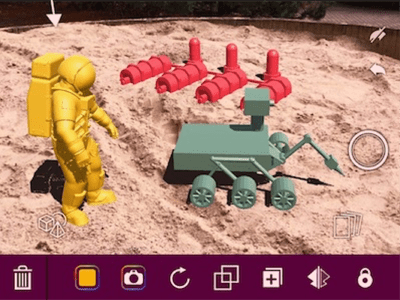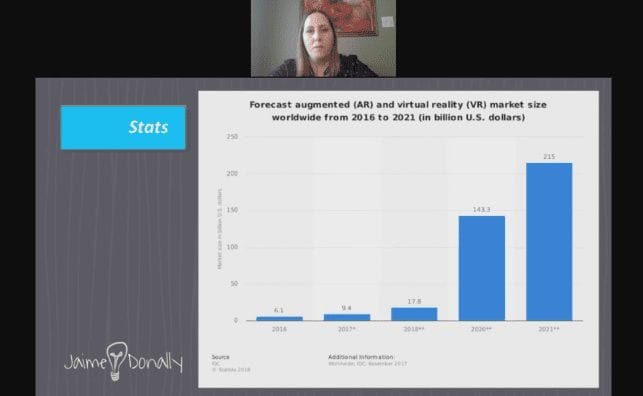10 Augmented Reality Apps for the Classroom
For teachers that have always wanted to use augmented reality (AR)—tech that overlays content on top of the real world—but haven’t had the chance to explore it, Jaime Donally has heard you. In her presentation, “Creating Classroom Content in Augmented Reality,” she gave attendees some inside help on which apps to use in the classroom. With programs ranging from beginner level to current AR practitioners, she offered 10 apps that can help educators get started with no coding skills needed.
- Curiscope: Using the Virtuali-Tee (a t-shirt with code embedded on it) and the company’s app, students can take an in-depth look at the human body. They can explore the body’s systems and get a deeper understanding of anatomy.
- Experience Real History (ERH): Starting with the Alamo in 1836, ERH uses cards and Reality Boards, in addition to the app, to let users get insights into history. The cards, for example, feature individuals from the time period, and when two cards are viewed through the app, users learn how the individuals interacted.
- Catchy Words AR: This app allows kids to walk around their house, school, playground, etc. and “catch letters.” Then, the student arranges the letters into a word. Donally found the app especially helpful to kids who were struggling with spelling.
- 3DBear: This program allows students and educators to create their own AR experiences by overlaying 3D models on reality. It’s not specific to any grade level or subject and can be used across many disciplines. It also comes with a few lessons to help teachers get started.
- Metaverse: Another app that allows the user to be the creator, Metaverse users develop experiences on storyboards that they can share with each other. Teachers have made quizzes, scavenger hunts, breakout rooms, and more with the program.
- Cospaces: This AR creation app has basic and pro levels that allow educators to create lessons across subjects and grade levels. There are development modes for beginners and experienced coders, so the AR can be as sophisticated as the teacher wants.
- Orb: This app lets kids build on top of the real world as if they are set-dressing a stage. They can also share their creations with others through the app.
- Merge VR: Not limited to classroom education, Merge VR technology uses headsets and a special MERGE cube to develop and deliver AR experiences for ages 10 and up.
- World Brush: Here, users are drawing on the real world and can share their creations with others.
- MoatBoat: With this app, students and teachers can type or speak instructions, and the program will create it.
While Donally understands that this tech is still growing, she believes it’s important for teachers to integrate it, where applicable, in their lessons. “That’s our students’ future,” she said.
This edWeb broadcast was sponsored by 3DBear Inc.
This article was modified and published by eSchool News and EdScoop.
About the Presenter
Jaime Donally is a passionate technology enthusiast. She began her career as a math teacher and later moved into instructional technology. Her desire to build relationships has brought about opportunities to collaborate with students and educators around the world. She provides staff development and training on immersive technology as an edtech consultant.
Her latest adventures include the launch of Global Maker Day and the #ARVRinEDU community. She works as an author and speaker to provide practical use of augmented and virtual reality with more resources at ARVRinEDU.com.
Join the Community
Computer Science & STEM Learning is a free professional learning community on edWeb.net that provides PreK-12 educators with a place to collaborate on incorporating computer science, coding, robotics, and STEM learning into their classrooms.





Comments are closed.